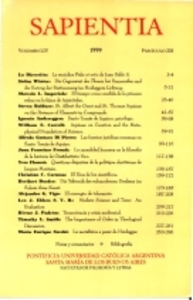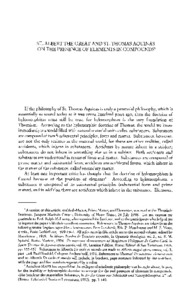Please use this identifier to cite or link to this item:
https://repositorio.uca.edu.ar/handle/123456789/12666| Título: | St. Albert The Great and St. Thomas Aquinas on the presence of elements in compounds | Autor: | Baldner, Steven | Palabras clave: | Tomás de Aquino, Santo, 1225-1274; Alberto Magno, Santo, 1193?-1280; ELEMENTOS | Fecha de publicación: | 1999 | Editorial: | Pontificia Universidad Católica Argentina. Facultad de Filosofía y Letras | Cita: | Baldner, S. St. Albert The Great and St. Thomas Aquinas on the presence of elements in compounds [en línea]. Sapientia. 1999, 54(205) Disponible en: https://repositorio.uca.edu.ar/handle/123456789/12666 | Resumen: | Abstract: If the philosophy of St. Thomas Aquinas is truly a perennial philosophy, which is essentially as sound today as it was seven hundred years ago, then the doctrine of hylomorphism must still be true, for hylomorphism is the very foundation of Thomism. According to the hylomorphic doctrine of Thomas, the world we know immediately is a world filled with natural material units called substances. Substances are composed of two fundamental principles, foral and matter. Substances, however, are not the only realities in the material world, for there are other realities, called accidents, which inhere in substances. Accidents by nature inhere in a subject; substances do not inhere in something else as in a subject. Both accidents and substances are understood in terms of form and matter. Substances are composed of prime matter and substantial form; accidents are accidental forms, which inhere in the matter of the substance, called secondary matter. | URI: | https://repositorio.uca.edu.ar/handle/123456789/12666 | ISSN: | 0036-4703 | Disciplina: | FILOSOFIA | Derechos: | Acceso abierto | Fuente: | Sapientia. 1999, 54(205) |
| Appears in Collections: | SAP - 1999 Vol LIV nro. 205 |
Files in This Item:
| File | Description | Size | Format | |
|---|---|---|---|---|
| sapientia205.jpg | 26,71 kB | JPEG |  View/Open | |
| st-albert-the-great.pdf | 273,3 kB | Adobe PDF |  View/Open |
Page view(s)
59
checked on Apr 27, 2024
Download(s)
124
checked on Apr 27, 2024
Google ScholarTM
Check
This item is licensed under a Creative Commons License

